Data East’s short-lived MLC system was probably designed to provide direct competition to the NeoGeo system, but arriving in 1995 after the NeoGeo already had a strong foothold in the market it was never going to do well.
The Flyers are hilariously bad, and highly inaccurate, talking about the competition as a 15-bit 68000 with the rest of the competition specs seemingly for a fictional system and then the actual ones for the MLC not really much more grounded in reality.
Either way, it was a ‘cartridge’ based system, not multi-game like the NeoGeo, but slightly closer to CPS2 in the way it works with a lot of the logic (including the game CPU) in the cartridge along with all the ROMs (in reality the motherboard only provides the sound & video circuits etc.) Interestingly Avengers in the Galactic Storm made use of an SH2 CPU while the others instead used Data East’s encrypted 156 ARM chip, I doubt the reasons for this decision will ever be clear. The encrypted ARM obviously provided extra security, but already existed when AGS shipped so the choice to use a completely different CPU lacking any security whatsoever was an odd one, not that it mattered, I’ve never heard of any of the cartridges being bootlegged at all.
Having previously worked with the NeoGeo for titles like Street Hoop and Karnov’s Revenge the influence on the video system design here is quite obvious. The MLC forgoes the usual Data East tilemaps + basic sprites combination and favors exclusive use of a much higher capacity zooming sprite chip. While the NeoGeo retained a simple tilemap for the text overlays this system lacks that too.
I guess the idea was to keep it simple, you no longer have to worry about multiple layers and priorities and how they’ll interact with each other, you simply have a spritelist drawn in order, one thing to learn, one thing to program.
One problem with an all-sprite system is that you lose the ability to do line effects, which makes the ‘3D capable’ points in the flyer even more laughable. There are ways around this, and Data East were certainly no strange to them. Karnov’s Revenge works around the limitation by using the scanline programmable interrupt timer on the NeoGeo to trigger interrupts on specific scanlines and change the content of spriteram during the active display, picking a moment after the processing for one line is complete, the very moment before the next one gets drawn in order to do the ‘rowscroll’ effects on the floor. It’s a common technique, and Data East had made use of it many times before, even on hardware where it probably wasn’t strictly necessary.
It’s no surprise then that the MLC system is capable of similar, it does however appear that the hardware designers shot themselves in the foot with this. You see the MLC spriteram looks (at least from what we’ve been able to gather) to be buffered. That is, the content of spriteram is copied to a private buffer for use by sprite chip when rendering. With this in mind it becomes impossible to change the positional values of sprites in realtime because the changes you make will only get seen next time the RAM buffer is updated, once per frame.
To compensate for this the hardware employs what seems to be a very kludgy workaround. Next to the scanline IRQ register are a set of 3 other registers with each one having additional x-scroll, y-scroll and x-zoom values, and any sprite can be told to use these ‘global’ values. While the spritelist can’t be updated in realtime these values can be, allowing for a similar effect to be achieved although limiting the possibilities in significant ways.
That’s probably enough background information anyway. You might be wondering how this actually relates to the games running on the system, and why I’m talking about it here? Well as it turns out at least 2 of the games on the platform make use of these features. Avengers in the Galactic Storm uses them to do a similar rowscroll effect on the floors (it’s very noticeably missing on some levels) and unfortunately I haven’t been able to make any progress with that one. The other game using it, extensively, is Stadium Hero ’96, a game that has never worked in MAME.
Implementing this was tricker than it might sound. The MLC renderer in MAME had been written in a way optimized for object rendering, in other words, rendering the entire content of the sprite list once per frame, drawing the full width and height of each object (within screen limits) at that point. That’s fine as long as you’re not trying to do realtime scanline effects. If you want to do realtime scanline effects you need to instead look to see if a sprite covers the current scanline and if it does render only the appropriate span of the sprite for that scanline, a rather different approach.
MAME provides a ‘cliprect’ system, clipping rectangles that you can use to limit the area of the screen that things get drawn to. For basic cases (assuming the rendering code acknowledges the cliprects at all) this can be used for to implement such effects, by simply passing a cliprect covering a more limited area of the screen (the scanlines you want to render) to your rendering code, pixels outside that area get cut off and the desired effect can be achieved. That’s essentially what the ‘partial updates’ you see in MAME sometimes is, it’s telling you that the screen is being rendered in multiple calls (currently MAME can’t go below scanline granularity in this with using core code, so it will never be greater than the number of scanlines)
The problem is once you start to get large sprite-lists and zooming sprites the ‘pass a cliprect’ solution starts to become highly inefficient. Forcing the MLC games to do 240 partial updates caused performance to drop to around 10% speed, from significantly higher. This is essentially because the point at which pixels got clipped out using this technique was the point at which they should have been rendered. Forcing 240 partial updates was actually near enough telling the code to render the entire screen 240 times, but only actually use one scanline of it from each call. As you can imagine, that’s not exactly efficient, it means your entire renderer is 240 times slower.
The key to solving this problem is early rejection. By rejecting sprites at the earliest opportunity, and calculating which line of a sprite correlates to the current scanline then you can save a huge amount of work, you’re no longer looping over every line and every pixel of a sprite only for it to not even show up in the final display because it doesn’t exist on the current scanline, nor are you even looping over extra lines of a visible sprite, you’re jumping straight to drawing the actual visible pixels for only the sprites visible on the current line. It’s obvious, but it needs more intelligent coding than the brute force approach.
Doing this in MAME is nothing new, plenty of systems have their own custom renderers for exactly this reason, the NeoGeo being one of them, but it still requires work, it requires reworking of code designed / optimized for one scenario to be rewritten in a way optimized for another instead. Doing this for MLC had been on my todo list for a long time, knowing there were games in need of it, and so it was good to finally get it done over the last couple of days.
The fun didn’t end there tho, there are a number of other poorly understood things about MLC, first of all there was the whole issue of how the global registers get selected, and also an issue of how they got used. The first couple of attempts at getting Stadium Hero ’96 didn’t really look much better than before, there were line effects going on, but they were completely wrong. A day or two of studying the values allowed that to be fixed however.
Stadium Hero ’96 also threw up another problem. The MLC has it’s own set of clipping windows (not MAME ones!) 8 of them to be precise. These can be used to clip sprites to certain screen areas, a feature used by Skull Fang to show the boss views when the boss if off-screen. Unfortunately the MAME code only had logic to select between 4 of them, and Stadium Hero uses all 8. I found what appears to be the higher select bit, fixing the garbage covering the game screen and allowing for the windows showing your guys on the bases to render correctly most of the time. I say most of the time because there are still problems to track down, the logic used by Skull Fang is contrived, and it’s possible Stadium Hero ’96 isn’t agreeing with it.
Actually all the bits used to enable clipping windows, raster effects and raster selection are slightly odd. I don’t think the current implementation is correct at all, and it’s possible setting one bit changes how other bits behave, but test cases are so limited it’s hard to know. One thing appears to be clear, if raster effects are to ever work in Avengers in Galactic Storm then the ‘enable use’ bit we currently use can’t be right (the sprites that need to be affected don’t have it set) but furthermore there is a problem that AGS isn’t even writing valid per-scanline values from what I can see, it sets a single set of global registers (and not even the ones our current select bits would reference) once per frame. I can only guess there are multiple issues, from it not liking the reads from one of the many unknown ‘vblank??’ handlers in the driver to some further way in which the select bits and enable bits can be changed.
Stadium Hero ’96 also had (has?) a further problem, protection. In addition to the encrypted ARM the game makes use of ‘146’ protection chip, although it only writes to it on startup, and then reads it many times during the actual gameplay / attract sequence. Kale chipped in and did some work here, correcting the return value for one of the protection reads and allowing the Title Screen to show, and gameplay rules / scoring to be fixed. It appears most of the checks are quite dumb, and probably really do return fixed values given the lack of writes after startup.
So anyway, the net result of all of this is that for u2 Stadium Hero ’96 will be massively improved, I’m hesitant to call it working because there could still be lingering protection issues, and there are almost certainly bugs caused by the clipping windows at least but it at least looks a lot better now, and can actually be played.
There are other outstanding bugs with the MLC driver I haven’t managed to fix, the regression with Hoops / Hoops ’96 test mode is a very annoying one, Mametesters shows it broke a long time ago, and it remains ‘broken’ If it wasn’t for us having default eeproms you wouldn’t actually be able to run the games at all at present because it’s still impossible to enter test mode, and without being able to enter test mode you can’t actually initialize the eeprom (or change any game settings) I’d actually be curious to find out the exact change that caused this failure because it’s most likely to point us at a fix. This is definitely a platform where some good hardware tests wouldn’t go amiss tho, even basic things like the zoom precision is questionable right now (and with my new code there is a very visible gap in the Stadium Hero ’96 logo zooming)
After that wall of text, here are some screenshots of Stadium Hero ’96
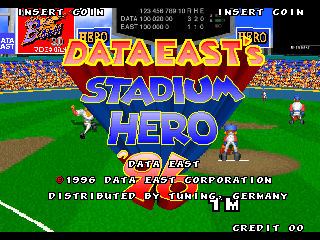
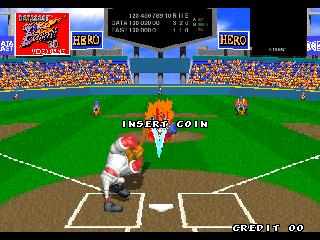

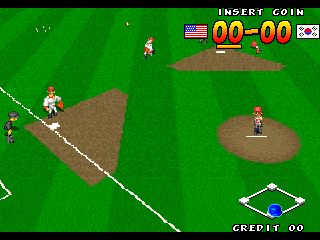
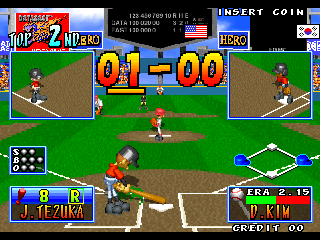
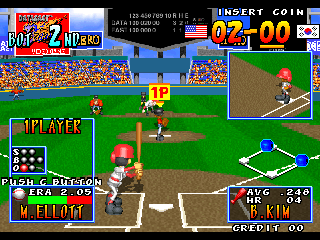
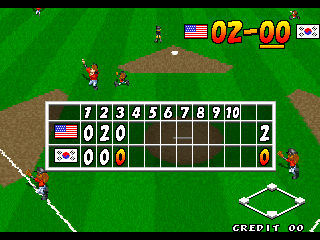
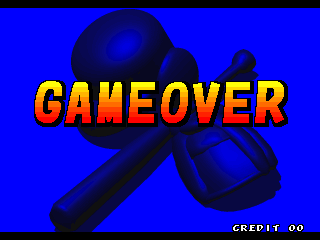
(Screenshots of the much improved Stadium Hero ’96, the 6th shot shows a likely remaining clip window issue)
This may be the best technical article you’ve written yet. Loved it.
Yeah, nice read. Data East’s output always was second grade, right down to their flyers apparently.
I have a feeling the flyers are made by Tuning, who seem to have been the official European distributor for the system / games.
I actually like a lot of the Data East catalog, many of the games have aged well also.
It’s just a shame they went all pre-rendered garbage for graphics around this time, you can see it in the ‘hoops95’ intro (unsurprisingly they replaced that in hoops96) Skull Fang suffers in a similar way, as does Avengers in Galactic Storm and Ghostlop on the Neo.
Things like Windjammers, Joe + Mac Returns and Boogie Wings are up there with the best arcade offerings tho. The Avengers Galactic Storm isn’t a bad game either, it’s just they opted for this rendered rubbish instead of the nice hand-drawn art Capcom put in their comparable titles.
Gaming always seems to go through bad stages / fads, be it FMV for the sake of FMV on early CD systems, this trend of pre-rendered graphics, or the digitized sprites. These days it’s all the locked down systems, DRM, always-on connections, central servers, DLC, and temporary ownership / appstore culture, and I’m sure we’ll look back on it as an equally dark period (if we ever get over it and go back to actually trusting users and giving them ownership of the products they buy) Always some idea trying to ruin gaming, before that it was the obsession with Quick Time Event sequences and dumbed down generic sequels, although I’m not sure we’re quite over those yet either if things like the new Tomb Raider are anything to go by.
Glad to see the backlash over the new SimCity, shameful sequel both in game quality, game ‘business model’, protection and well.. everything really, completely sums up everything that’s wrong with the industry today, and even has a premium price to boot. I’ve had more hours of fun messing around with the previous SC games than it’s best to remember, including user mods, hacks and trainers, but bet if you even attempted to do the latter on the new one you’d lose your entire game account and access to anything else you’d purchased thanks to all this always online, tied to an account nonsense. They had a guaranteed audience, large number of pre-orders, etc. and yet it’s everything a sequel should not be. It defies belief really, all they needed to do was create a bigger, more modern, more badass version of SC4 with more to do, better AI, etc. and instead we’ve ended up with something that would be more suited to being a Facebook game.
For better or worse, I don’t think the concept of physical or permanent ownership will return in the same way as the past. This trend is echoed through other digital media: digital books, Spotify and NetFlix. The convenience of being able to always access a wider range of content seems to win over most people.
Physical formats will become a niche like vinyl records, for a small subset of fans and collectors.
Digital formats will be always connected, and non-playable once the servers are taken offline. Unless dedicated hobbyists can reverse engineer the server components, or companies take an open approach and release the server component once they sunset a title.
What I do see changing is the business models attached to games. Right now there is a huge push towards free-to-play, a little like the drive towards ‘realism’ and 3D in the mid-90s. I think in hindsight developers will realise there is plenty of room in the market for both freemium and premium titles and business models. Much as there was still room for 2D titles (see the resurgence of Puzzle Bobble clones with millions of daily players on the Facebook platform).
In many ways I’d say the present era is one of the most fruitful times to be a gamer. When you combine the avalanche of cheap innovative mobile content with the epic production values of traditional console titles, we’re spoilt for choice!
I guess experiences differ, there is very little today that interests me at all, there are cases where I want to pay for something, but the product I want to pay for isn’t being offered.
That’s what bugs me about the Sim City thing, I didn’t read up too much on it beforehand because I didn’t want to spoil any surprises it might have, I wanted to be amazed by it when I played it.
It’s the same with a lot of other ‘premium’ games and the DLC, I’ve thought about buying some of the ports of Cave shooters and the like for the 360, but then I see half the modes are being offered as ‘not on the disc’ DLC, even when said content has been finished for years. For me that’s an instant ‘no purchase’. The inability to download and store patches for the modern games for offline use and application later is also a major concern for me, I doubt the updates will be available forever and most games seem to now ship with critical game breaking bugs.
Mobile has never interested me, the only phone I have is an ancient Nokia, it’s a phone. I have a nice big screen on my desktop, why would I want to play games on a phone with horrible touchscreen / motion controls?
Movies have never interested me, and most games today are like movies.. The ones that aren’t seem to be turning into crap like Sim City, a genre I loved decimated.
I’ve never been a big fan of online games either, last one I played extensively was Quake *2* and everything after that has just felt a bit ‘meh’ I tried some MMORPGs and they just seem like an excuse for not having a real game at all but instead a glorified chatroom again and really dumb gameplay.
So I end up buying nothing, I end up playing the same games I bought years ago, which makes me realise even more I don’t want to be buying the games that are being released now, because even if I do end up liking them I won’t have that ability later…
People say it’s more social these days, but to me it seems less. Sharing with your friends is impossible, you can’t take your ‘cool’ DLC with you to a party etc. and with one time use codes for online play you can’t even really take other games to have a blast either.
So to me these are dark days, and I hope things do improve because it’s an industry I care about passionately and have always loved, but lately I’m finding nothing at all to love.
Is this simply the fact that most of us have been playing games for 25+ years and have high expectations combined with a healthy degree of cynicism towards change? I’m not sure your average 16 year old cares about Apple’s DRM and not owning the game permanently. It’s normal to them.
If you compare the experience of an iPad with appstore connection and a lifetime’s worth of free/69p content, vs. the Spectrum’s relatively expensive games, the experience is favourable.
(Amusingly, a lot of those Spectrum games failed to load for me too… somewhat mirroring the connection issues complained about today.)
It’s difficult to find a game that excites me as much as the early games. But I’m sure this is a side-effect of having played so many games, as opposed to the games themselves…
The Spectrum was about a lot more tho, even to me as an 8 year old kid, part of the fun was the games, the other part was finding out some of them were written in basic, and hacking them up and sharing your findings with friends, or the community as a whole via magazines which actively encouraged such.
Likewise the ones that actually shipped with extensive editing tools, that was a major selling point for me because you not only had a game, but basically the ability to make your own game out of it too.
I’d say the always-on stuff was more akin to Lenslok
http://en.wikipedia.org/wiki/Lenslok
It’s screwing over your paying customers for the sake of it, I was unlucky enough to get some of these games, it meant they could only be used with 1 TV in the house, and that’s if you were lucky. Usually you’d spend a few minutes loading the game only to be booted out because you got the code wrong. Didn’t buy another game from the companies who used it back then, think I ended up using the actual device as some cyborg fancy dress.
We seem to go over this every couple of years, and each time a generation of people get burned by it. The Amiga ended up similar, I stopped buying games there because the copy protections ended up being more inconvenient than you could care to believe.
We have the technology to do some REALLY cool things these days, MicroSD cards so tiny you could carry TBs in your pocket, however what we can actually do is severely restricted by policy, business interests etc. It’s sad. How amazing would it be to be able to take ALL your Rock Band / Guitar Hero DLC on an SD card to your mates house and play it all at a party? or even just user content, like all the levels you made / downloaded on Little Big Planet without having to navigate through some online system (which won’t be there in a few years..)
We could be doing things like that, which are a more direct comparison with what you could do back then, but you can’t despite the technology being there.
The other problem with mobile / phone devices is again they’re very PERSONAL devices, they’re not something you pass around and share with friends, or all gather around to play, and for all the connectivity we have the actual gaming side becomes rather isolated. For consoles, even if you’ve made a game, if it’s a digital download one you can’t show your friends by loading up what you made on their xbox because you have a copy, you have to convince them to buy it, and if they don’t like it then you just made one of your mates waste their money, not cool.
The central server thing for all online games / services likewise does as much harm to the social aspect as it does good, it ensures a game will die. I could quite easily go and set up a Quake 2 server now, have a lan party, and play the whole thing just as I did back in the day, have a blast, yet due to the way things are done now you can’t do that for many, many games from more recent times, the server code, however advanced / dumb it might be is simply unavailable, so again something potentially amazing is ruined completely, can’t even do player vs. player with a direct connection (yet I can pick up a copy of Stunt Car Racer on the Amiga and do exactly that without having to worry about such issues)
The main ‘social’ aspect these days seems to be more nagging your friends into buying something / playing a game you don’t want to play just to shut them up.
We’re even turning cheaters into criminals thanks to all of this. Back in the day cheats were a bit of fun, and while I can understand people not wanting cheaters in online FPS games etc. we’re now seeing a model where (thanks to stupid DLC / ingame credit schemes / ‘achievements’) cheats, glitches, even in single player games, are considered to not be fun features, but exploits, with severe punishments such as losing your entire account for using them (unless you happened to buy them as DLC..) See EAs previous piece of crap ‘Dead Space 3’ where again they have an interesting game mechanics *ruined* by this kind of scheme despite the actual game on offer being technically decent. What next? Am I going to have to buy the ‘tank’ cheat code for GTA, with a limited number of uses before I have to buy it again? Again if something like that happened (and it’s the path we’re on..) it kills the social aspect because instead of just being able to piss around with friends in the game using such codes for a laugh it starts to cost real money and stops being ‘cool’.
I see very little reason for cheer about the current state of things and do wonder how much further down this path we’re going to go, I think a fair number of people are starting to feel the burn of it, but there will always be an increasing number of new suckers to fall for it all and continue to pay for the abuse. Maybe if I was more interested in actually pirating the modern stuff I’d have a brighter view of the games in general, but I’m not, I’m just dismayed at the unavailability of the products I’d like to buy once I look at the limits on the ones actually available to me.
Maybe it is the 25+ years, and a high degree of cynicism thing, but I’m not convinced it’s that alone. Too much of it is simply no longer about the games and providing something to just have fun with, but instead controlling exactly what you have, when + where you have it, and how you use, and what you can do with it once you’re finished with it, something more akin to an abusive relationship I simply don’t have time for. I guess the good part is it does give me a lot more time to look at things like MAME ;-)
I think the glimmer of hope is that the tools and means to produce high quality games are more readily available than the past.
Sure, you could switch on the Spectrum and program straight away (which was great) but you weren’t going to code an Elite beater in Sinclair basic. The professionals were all using PC/68k based setups by the late 80s and piping the code and assets over, as you will know.
It’s once again quite possible for a small 2-3 man team, using Unity or similar tech to produce a relatively accomplished and financially successful title.
This will lead to more shovelware, much as the availability of cheap music production software has led to a deluge of bland electronic music, but there will be some gems in there too :)
I totally agree that a lot of the latest technology is underused, and the SD card idea you mention makes total sense. I love what ID did with open sourcing their engines as the games aged to enable users to create new content and mods. I wish more companies followed that approach….
It would be much better if your small 2-3 man indie team could make a game, put it on a physical disc and sell it tho.
Aside from PC, that’s not possible with the current generation, and it’s a big loss.
If you’re in a band, you can burn off some CDs, sell them to people, and they can show their support by buying them, at which point they can rip them, play them, or just keep them as a token of memorabilia.
If you want to make a game you don’t have a comparable ‘in every household’ fixed platform device to do the same, PCs vary wildly, phones likewise, and for the major consoles there is no open way to get your code on there without going through the middlemen and having to pay somebody else just to do something you novel or where you don’t really think you’re likely to make much back.
That’s a real shame, and probably why you’re still seeing some indie developers offering games for platforms like the Dreamcast, it’s the last one available where people still have a good chance of being able to run what you’re offering without resorting to hacking the machine, but even that becomes more of a niche market every day.
I thought the PS3 linux thing was a good idea, although the limits it imposed on you made it practically impossible to get anything decent out of the hardware and even that wasn’t there by default, you had to install it, and eventually Sony decided to pull it completely in an update.
These are all artificial limits, they exist to control a market, they exist to prevent competition, and I’m not a big fan of them.
There is plenty of shovelware from the big names anyway, and I don’t buy the argument that any of this prevents it, the market in general will filter it out.
All of this is without even considering the games, and why the underlying games seem to be getting worse even if the graphics are looking better than ever? Again the new SimCity appears to be a prime example of that, and while I guess it’s possible the whole thing has effectively been sabotaged so that content can be put in £400 worth of DLC and expansion packs, I don’t think that’s the case, a decade of computing progress and we appear to have a game with less technical depth than any of it’s predecessors.
I had the misfortune of playing the latest Hitman game too, I had a feeling it wouldn’t be great because of the level of advertising I was seeing for it (I’ve noticed there seems to be a direct connection between how heavily a game is pushed and how bad it turns out to be) Now I’ll admit, I might have got a wrong impression of it, but it seems the series has been slowly losing what identified it as something different for a while and if I look at some of the user reviews on Metacritic they tell a similar story to my experience with it.
The Settlers series went the same way, a favourite from my youth, the latest versions look more like generic RTS games carrying the name.
The new Jagged Alliance game is one I played through, but graphics aside, it’s just a weaker remake of JA2, and was basically unplayable at first (took many patches to add fundamentally essential game elements back)
The list goes on and on and it seems the majority of the time I’ve gone against my initial judgment and actually decided to give something a chance I’ve been left disappointed, and wishing I hadn’t wasted my money.
Maybe my expectations are too high, maybe I should accept that some things change, but when it’s the elements of games that made the games what they were being stripped out, or replaced with inferior versions then I’m not sure it’s my expectations that are out of line. You wouldn’t release a new Sonic game with the game mechanics of Mario… or at least you wouldn’t unless you were a chinese pirate ;-)
There is some good new IP out there, I’ll admit that, but even then a lot of it is wrapped up in disappointingly easy or short games, bolstered by DLC which then instead of feeling like part of the game simply feels tacked on. Many of my favourites are actually games that couldn’t be completed (open ended) or I never managed to complete, the enjoyment came from playing the game, not finishing it.
Have you tried some of the recent indie titles, for example, Fez or Retro City Rampage?
Retro City Rampage is a good example of a small team, pretty much one guy apart from the audio, releasing a title across PS3, Wiiware, PC etc.
http://retrocityrampage.com/
Independent cross platform can still be done. Unity facilitates a lot of the differences between phones and devices. Although clearly it’s not as simple as just pressing a button and spitting out a build.
These artificial limits imposed by developers have always existed to some extent. This includes the copy-protection methods of the 80s you cited earlier through to the closed nature of the early consoles. It doesn’t mean they’re the right way to go of course.
After all, can you think of an example from history of a title being financially successful as a result of its strong DRM? ;-)
Fez looks kinda interesting, I probably missed it because I really don’t look at XBLA etc. that much (as I said, I like to *own* the games I buy) which again makes it a shame, because some of them I would otherwise buy end up appealing less. I do occasionally break that rule for something if it comes highly recommended to me but for the most part it actually significantly drops the appeal down (and thus what I’m willing to pay)
Truth be told I don’t even connect my xbox online except to download game updates, because online gaming doesn’t interest me. When I do play them it’s because I’ve suggested my brother buy them based on recommendations and agreed to go half and half on the cost, even if these days we have the ridiculous situations where said game is locked to a single system because it doesn’t exist in physical form. That’s another concept lost tho. Try explaining to kids who have had their parents go through a divorce why they can’t play their games on their xbox because it was also their dads xbox, and their current xbox is different…. not my situation, but it is one I’ve encountered more than once.
Retro City Rampage looks a bit heavy on the ‘novelty’ appeal, I’ve seen videos of it before and not been over-convinced by it, it’s one of those in the past I would have probably borrowed off somebody to play for a bit, but you can’t do that with digital games….
If the people who made these could have burned them to disk, and mailed them out on demand I think you’d see them in more places, sure, copies would be sold 2nd hand instead of new, and there would be piracy, but I think market presence in actual stores is still one of the best forms of advertising you can get. Even just a game box lying around at somebody’s house is enough to grab your attention, maybe suggest playing the game, or asking about it, but with everything locked away inside an xbox that’s gone, completely.
From Dust was the last XBLA game I played and was really impressed by from a technical point of view, however I completed it in 2 days, and that was it, no sandbox, and surprisingly little replay value because the game builds up what you can do over time so just feels too limited for most of the game once you’ve finished it. In contrast, I still haven’t completed the original Populous to date (I’m not sure you can) I always reached a point where the game would beat me and that makes it timeless.
Quantum Conundrum got a playthrough, but again, very short, and just when you think the game is going to get good it ends and you’re left feeling there really was no challenge at all.
Maybe the idea was to leave me wanting more, but instead they both ultimately just left me feeling empty, wondering ‘what if’ in terms of if we’d had the tech to put these out in a previous generation.
Both games suffer from a problem of feeling one one long tutorial, at no point do they ever throw you out to fend for yourself thus at no point do you ever really feel like you’ve accomplished anything. Imagine if Lemmings had been released with only the first difficulty level if you will.
Like I said previously, we have the ability to do some really quite stunning stuff these days, on a gameplay mechanic level, From Dust being a good example of that, but in terms of actual content, replayability, and maybe overall ‘design’ I find them lacking.
i totally agree…golden era of arcade/console, pop, even porn…all gone…I really MISS THE 80’S!!!…mankind has to be stirred up
p.s. about the stadium here ’96,
it seems only two places with the clipping windows problem…’homerun’ scene and one in the screenshot
I’m told by Kale the ending uses it too, so I have a few use cases to work with :-)
The (old) hoops crash bugs annoy me more, especially because it isn’t obvious exactly what change caused them.